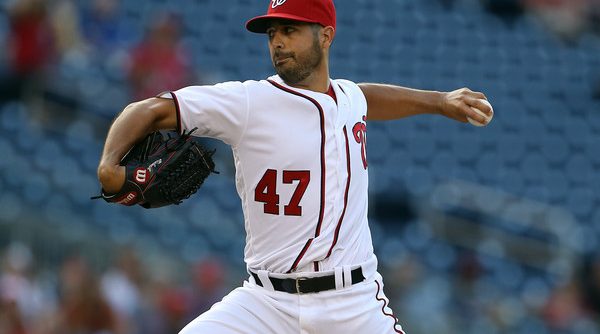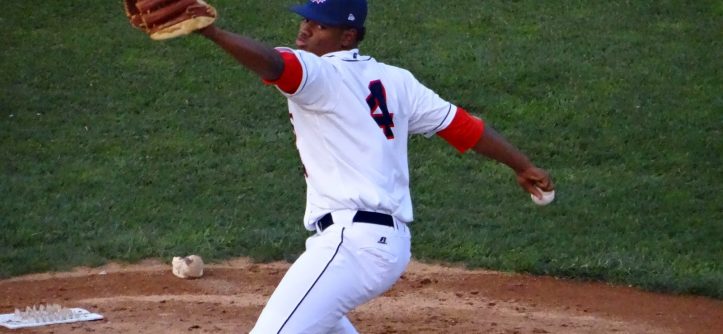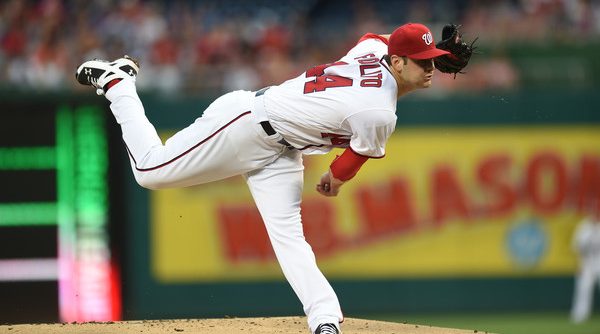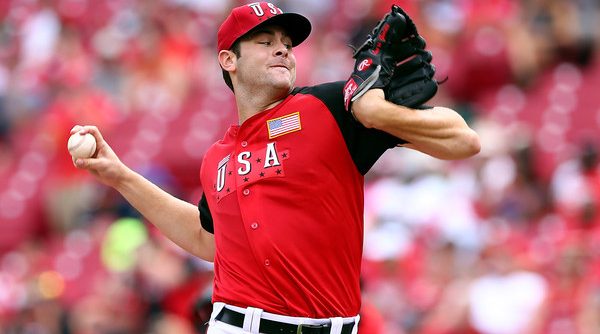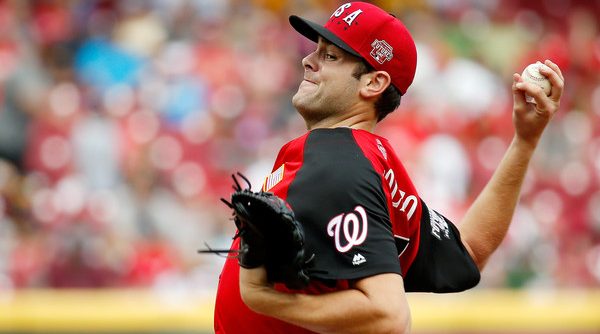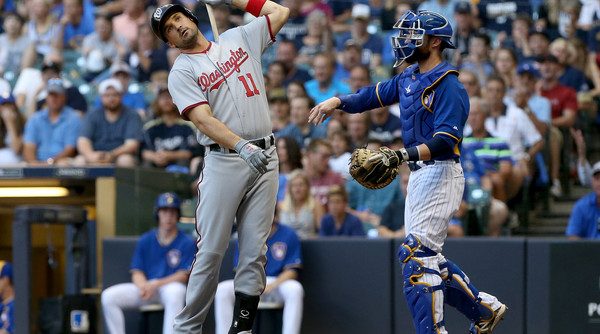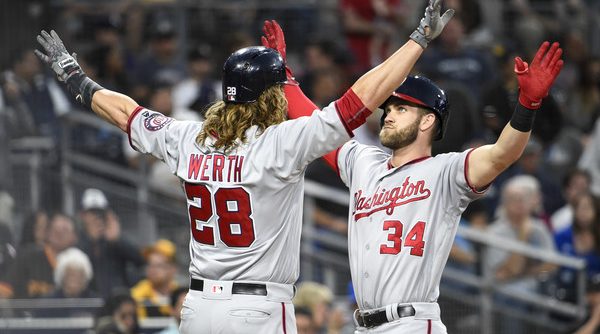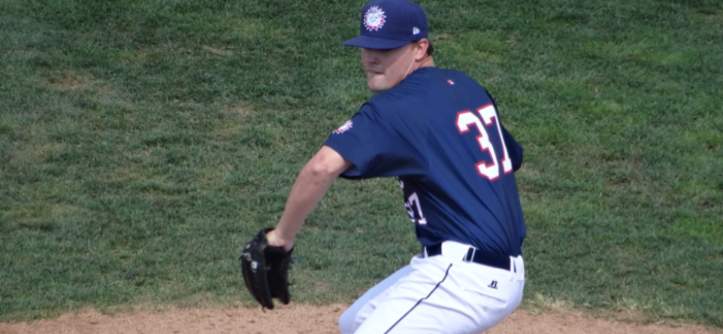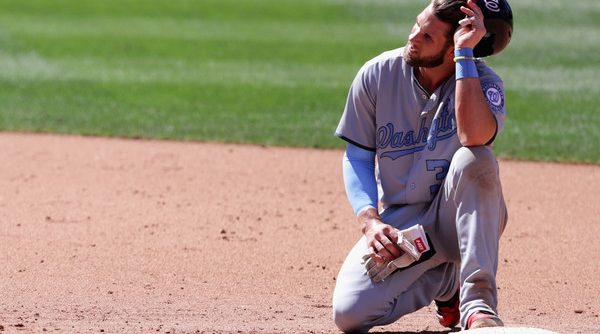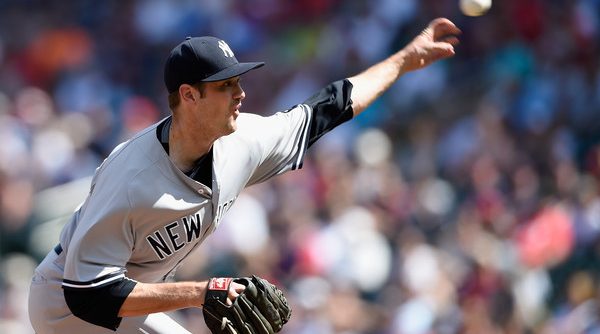The Washington Nationals may be soon faced with quite a difficult choice. No, not Trea Turner versus Danny Espinosa — I think Espinosa’s seven-RBI performance against the Reds put that to bed for a little bit. The Nats have too many options and too few roster spots. With Stephen Strasburg’s imminent return to the roster and the solid debut from the number one prospect in all of baseball in the form of Lucas Giolito, the Nats now have six potential options for their starting rotation and only five roster spots. Compounding the problem for the Nationals, after a hot start, Gio Gonzalez has not performed well and his struggles and stuff are in stark contrast with Giolito, which makes him and easy target for demotion discussions. Decision time for the front office: Do they keep Giolito up at the major-league level and adjust the rotation or send Giolito back down to Triple-A Syracuse for more seasoning?
Tag Archives: Nationals
Federal Reserve: Promotions Shake Up Farm System
This week was highlighted by the promotion of Lucas Giolito to the majors, but that was not the lone transaction that reshaped the Washington Nationals organization. On Monday, the team announced several high-profile promotions within its minor league ranks, including Reynaldo Lopez and Chris Bostick to Triple-A Syracuse, Drew Ward and Andrew Stevenson to Double-A Harrisburg, and Victor Robles and Max Schrock to High-A Potomac.
Continue Reading Federal Reserve: Promotions Shake Up Farm System
Giolito’s Big Debut
The Nationals have a thing about calling up stud pitching prospects on Tuesdays in June. The OG of Nats pitching prospects, Stephen Strasburg, set the bar pretty high for MLB debuts. He went seven innings, had 14 sensational strikeouts against the Pittsburgh Pirates and allowed only two runs, both coming on a two-run home run. Despite a one-hour rain delay to start of the game, Lucas Giolito, the next Nats hyped pitching prospect, lived up to Strasburg’s lofty precedent before his night was cut short by yet another rain delay.
Nationals Promote Giolito
The wait is over, as Lucas Giolito is officially a Washington National. The prized right-hander will be promoted to start on Tuesday against the New York Mets, taking the place of Stephen Strasburg, who has been placed on the 15-day DL with an upper back strain.
Voth v. Giolito: Who Should the Nationals Call Up?
The Washington Nationals announced Sunday that Stephen Strasburg would be placed on the 15-day disabled list after being scratched from his start in Milwaukee the day before. After the team’s 3-2 win, manager Dusty Baker announced that Joe Ross would start Monday, and a minor-league call-up would start Tuesday. But Dusty left out one key piece of information: Who is that going to be?
Continue Reading Voth v. Giolito: Who Should the Nationals Call Up?
Mythbusting Zimmerman’s Bases-Loaded Struggles
In Saturday’s loss against the Brewers, Ryan Zimmerman hit a sacrifice fly with the bases loaded, which means he didn’t get a hit in yet another high leverage situation this season. Despite flashes here and there, Zimmerman has struggled offensively this season. Those struggles have been exposed in high leverage situations thanks to the new found strategy of intentionally walking whoever hits in front of Zimmerman. Joe Maddon may have some creative get-away outfit ideas, but as a Nats fan I’ll take a hard pass on his trend setting idea of walking Bryce Harper to get to Zimmerman. That means he has had his fair share of bases loaded chances and has failed to really deliver on those opportunities. How bad has it been? Let’s take a look.
Continue Reading Mythbusting Zimmerman’s Bases-Loaded Struggles
Off-The-Field Recap: Father’s Day Edition!
The Nationals’ relatively promising road trip has spiraled into a stretch barely short of a disaster. Losing in the situations the Nats have found themselves in can be less than fun, and so, in order to combat such gloom, all of the player’s amusing off-field exploits are recapped here:
Federal Reserve: Koda Glover Continues Rapid Ascent
Koda Glover’s ascent up the Washington Nationals minor league ranks is continuing, as the right-hander made his debut at Triple-A Syracuse on Tuesday.
With the scoreless inning from that outing, Glover’s season totals across three minor league levels include a 2.18 ERA and 12 K/9 rate over 33 innings pitched. While the Nationals knew that they may have found a potential prospect upon selecting Glover in the eighth round of last year’s draft, his performance this year has exceeded the highest of expectations.
Continue Reading Federal Reserve: Koda Glover Continues Rapid Ascent
Is Bryce Harper OK?
I had the pleasure of being in San Diego this weekend for the Nationals’ series with the Padres. In the midst of Saturday night’s game, though, my enjoyment of the beautiful weather, scenic ballpark and momentary Nationals’ lead was shattered by a gentleman sitting behind me in a Padres jersey. This gentleman, you see, was talking smack about Bryce Harper. Now, I enjoy good smack talk, even if it’s about Nationals players. But it has to be smart smack talk. This particular Padres’ fan was comparing Bryce Harper to Mattt Kemp because, as he put it, they both are hitting .250 and Kemp has hit more home runs. You will be proud to hear, The Nats Blog readers, that I didn’t react with anger or aggression at this mistaken Padres’ fan, although I really wanted to. No, I did what any good millennial would do and tweeted about it instead.
It’s taking superhuman strength to not turn around and correct the Padres fan behind me who thinks Harper is overrated
— Joseph Seib (@seibj10) June 19, 2016
Now, this anonymous Padres fan wasn’t wrong in citing Harper’s batting average and home run total in the sense that he obviously had those stats correct. What he missed and what got me upset is that said Padres fan didn’t see or didn’t understand the bigger picture. Thanks to Harper’s .406 on base percentage (a higher OBP than Daniel Murphy, owner of a .367 batting average, by the way) he’s still a top 30 player in all of baseball by FanGraphs’ WAR. Matt Kemp, the comparable player in the eyes of everyone’s favorite Padres fan, has only a .274 OBP. Combine that with terrible defense in right field and he has actually been worth negative WAR. So take that, Padres fan!
There is some bad news, though. Since the Cubs series when Joe Maddon infamously intentionally walked Bryce 173* times (*estimated), Harper has been struggling. He’s hit for only a .246 batting average since that May series with an ISO of .127 — more fitting for Ben Revere than Harper. He’s been tentative on pitches in the zone, swinging at fewer pitches in the strike zone than ever before. Bryce is making more soft contact than normal and hitting more ground balls as a result. Especially concerning, he’s struggling to handle four seam fastballs. After hitting .322 against four seamers in 2015, Harper is struggling to a .189 batting average against the pitch. What’s more, it looks like pitchers have found an area of the zone to attack Harper: up and away. Harper is very obviously a low ball hitter, so pitchers usually keep fastballs up in the zone against Bryce. Since that Cubs series, though, they have focused on the outer corner of zone with the hard stuff (graphic courtesy of BaseballSavant.com):
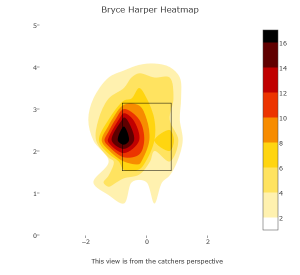
And pitchers have been successful doing so, as Harper’s sub .200 batting average suggests.
Ready for the good news? There are signs to suggest that this is a temporary slump and Bryce is close to turning things around. The biggest sign is that Bryce is not chasing pitches out of the zone, pressing to get out of his slump as he has done in the past. In fact, he’s swinging at noticeably fewer pitches out of the strike zone and cut down on his total swing and miss rate. As a result, his OBP is still stellar, which means he’s still getting on base at close to a .400 rate in the midst of this slump. On top of that, Harper’s BABIP is a career-worst .260, miles off of his career rate of .322 and his .369 BABIP last year, so he’s been on the wrong end of some batted ball luck. On top of all that, Harper’s struggles with fastballs up in the zone are new thing this year. Last season, although he was a better hitter against pitches down in the zone, he still hit for a solid average against fastballs up in the zone.
It doesn’t seem likely that the league has found some huge hole in Harper’s swing and has solved the puzzle of how to pitch to Bryce Harper. In fact, the Padres found out how attempting to attack Harper up in the zone with fastballs can backfire. Thursday night, Erik Johnson followed his scouting report and threw a fastball in the upper corner of the zone. Johnson made the pitch he wanted:
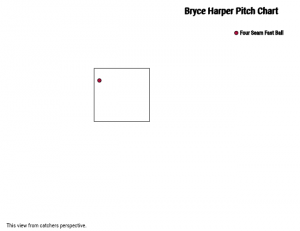
Instead of flailing away, Harper drilled it down the left field line for a home run.
Yes, Bryce has been in a slump. Yes, the league has found a short term plan of attack that has been successful against Harper. Yes, Bryce has been tentative and hasn’t been able to square up the ball as consistently as fans are used to. But he’s clearly gotten some bad bounces. He’s not swinging and missing more. And he’s adjusted to the league’s new approach against him. If opposing teams are willing to keep betting that Harper will struggle against fastballs, Nats fans should be happy to be on the other end of that wager.
Examining Trades for Aroldis Chapman and Andrew Miller
Two weeks ago, our very own Zach Spedden wrote about some internal options the Nationals might have if they wanted to replace Jonathan Papelbon in the closer’s role. Many Nats fans got their wish in a perverse way when Papelbon went on the DL on June 14th, pushing every other reliever into a slightly more demanding role to compensate. Since then, the relief corps has proven alarmingly thin. Regardless of whether or not the Nationals choose to replace Papelbon in the ninth inning, acquiring a reliever for any role seems like it could be the team’s top priority by the August 1 trade deadline.
The first complication with this exercise is considering which teams are going to sell. The standings can change quite a bit in a month and a half, and quite a few teams are close enough to a Wild Card berth to keep hope alive for now. So instead of speculating on losing streaks, I will focus on two pitchers to whom the Nationals have been connected frequently: Andrew Miller and Aroldis Chapman.
Both Chapman and Miller are unusual cases, though for very different reasons. Miller only recently became a reliever, but is now 31 and has a 1.87 ERA since the start of 2014, along with a stupefying 15.1 K/9 and stingy 2.3 BB/9. He is under contract for two more years at $9M each after 2016, so he could be the long-term answer at closer the Nationals have sought since the franchise moved from Montreal. But given his ability and contract, he will fetch a hefty price in any deal.
The New York Post’s Joel Sherman notes that the Nats are not likely to move über-prospects Lucas Giolito, Trea Turner, and Victor Robles, though he wonders if Miller is attractive enough to land one, perhaps when paired with speedy center fielder Brett Gardner. But the Nationals reportedly considered the trio untouchable at last year’s trade deadline, and Robles has since raised his stock even higher, while Turner and Giolito have held steady as two of baseball’s best prospects who figure into major league plans very soon. It’s quite hard to see any of the three going anywhere. That would leave flamethrowing righty Reynaldo Lopez, who has struck out 45 and walked three over 23 2/3 innings in his last four full starts, and 2014 first rounder Erick Fedde, who has 48 strikeouts and 12 walks in 49 innings at High A this season, as the top trade chips. They may not be enough to nab Miller, but they could intrigue the Yankees for Chapman.
Though Chapman, famed for touching 103 miles per hour, has been just as successful as Miller recently, he will come at a much lower price for two reasons: he is a free agent at the end of the season, and — much more importantly — he was questioned in a domestic violence incident in the offseason after allegedly choking his girlfriend and shooting a gun in his garage, which resulted in a 30-game suspension. General manager Mike Rizzo has long sought after Chapman, and Dusty Baker, who managed him in Cincinnati, publicly defended him this offseason.
Discussing what it means to acquire a player punished for domestic violence requires an article much longer and more thoughtful than this one. I could not possibly do it justice without dedicating an entire post to it, so I will minimize the role of my opinion and hew towards what I think the Nationals might do.
Chapman got off light for a terrible act, though even a heavy punishment from MLB would not have redeemed him in the eyes of many. Adding Chapman would alienate and rightfully anger many fans, but the same was true of keeping Papelbon last offseason. Rizzo backed off his pursuit of Chapman last offseason after the allegations against the closer became public but said their interest was on hold only “until we find out how things happened,” which does not sound like a categorical condemnation of his actions. Rizzo has shown that he is unafraid to make a move that will upset fans, but Papelbon’s actions are child’s play compared to Chapman’s. The Nationals’ interest in Chapman will depend almost entirely on how Rizzo weighs his crime, and that is a question only the GM can answer.

